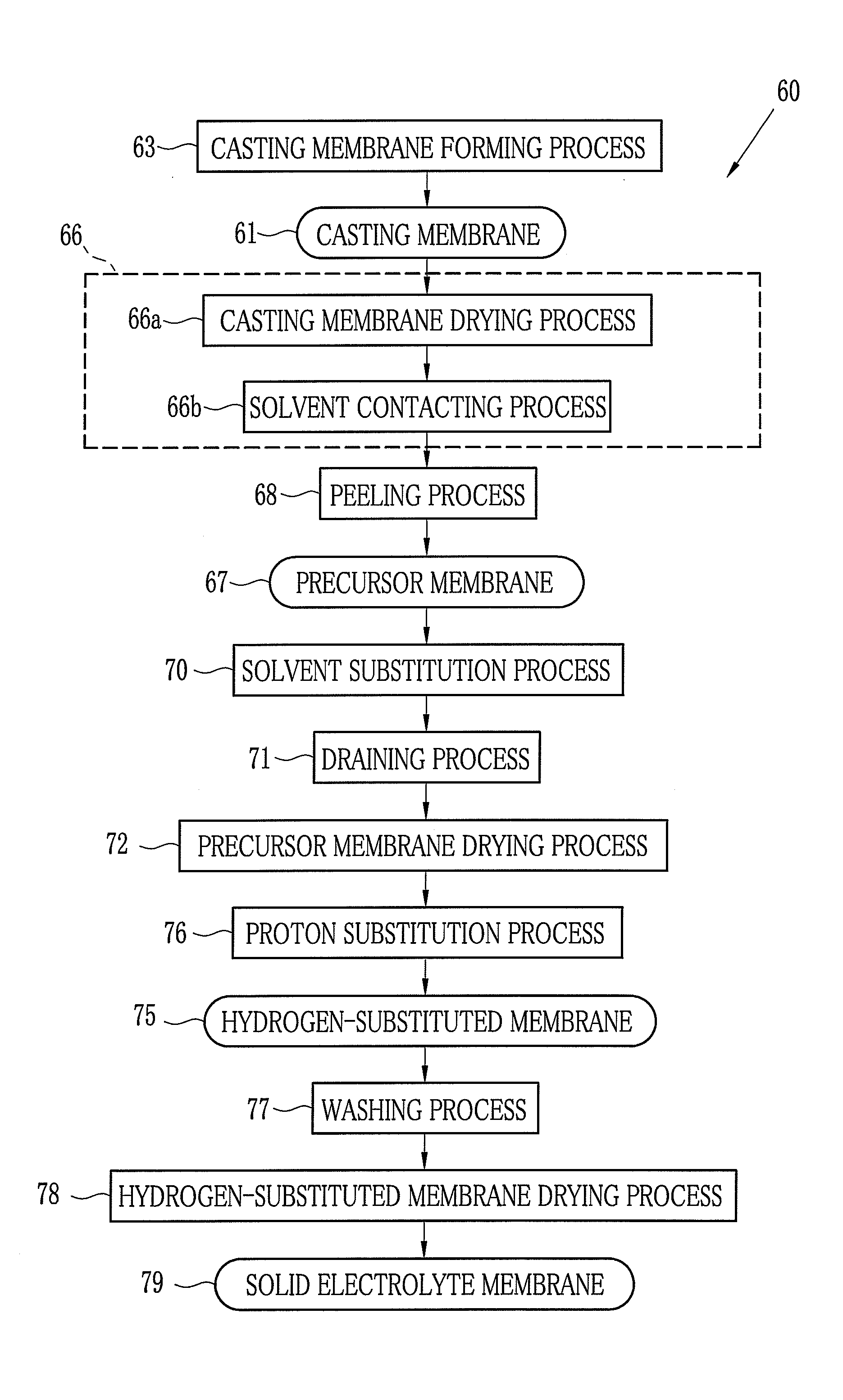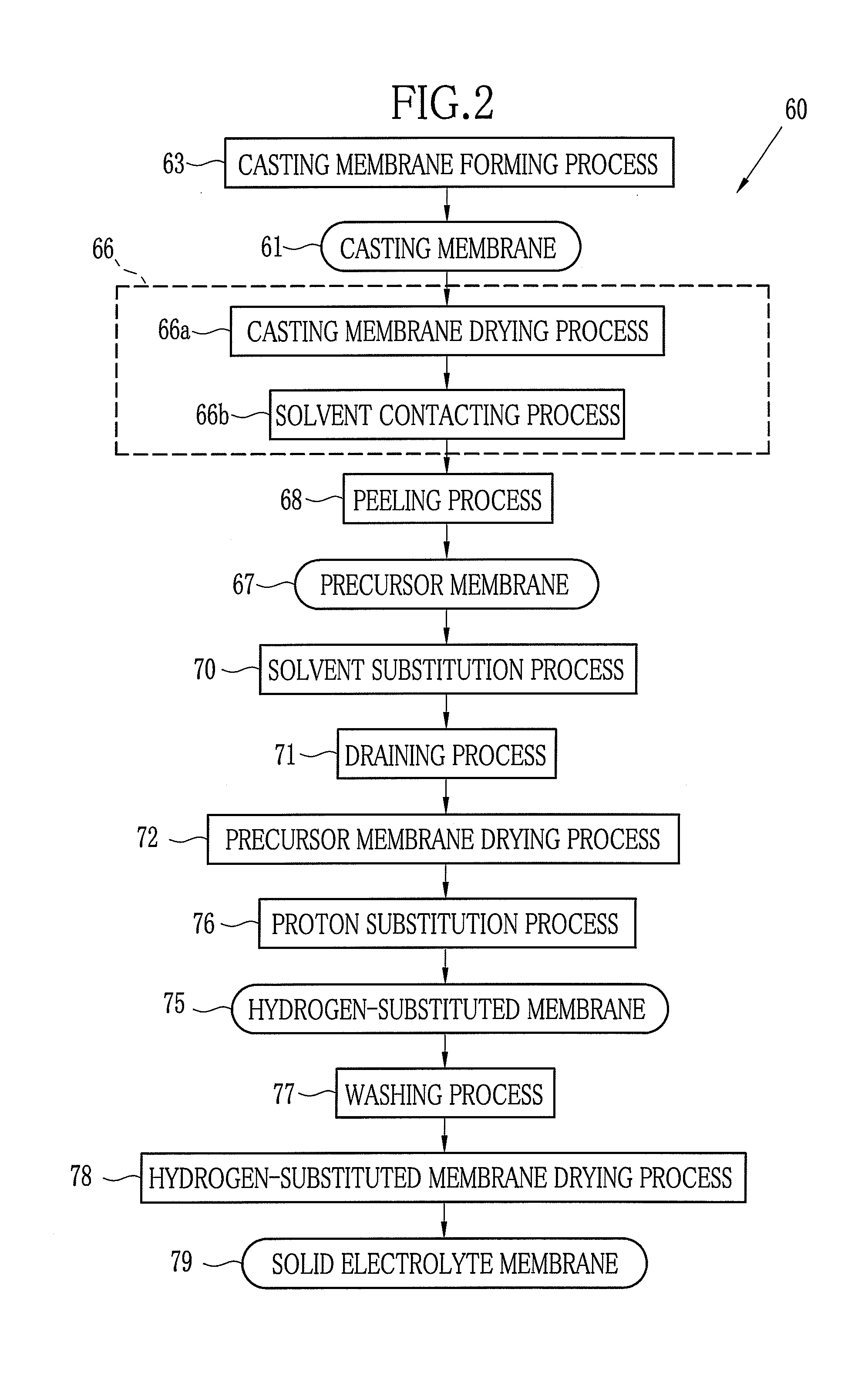Solid electrolyte membrane, method and apparatus for producing the same, membrane electrode assembly and fuel cell
a solid electrolyte membrane and fuel cell technology, applied in the manufacture of fuel cells, conductive materials, fuel cell details, etc., can solve the problems of insufficient electromotive force of solid electrolyte membrane, large and complex facilities, and denatured polymers, so as to achieve superior electromotive force and reduce the time for the second and fourth processes
- Summary
- Abstract
- Description
- Claims
- Application Information
AI Technical Summary
Benefits of technology
Problems solved by technology
Method used
Image
Examples
example 1
[0215]Next, examples of the present invention are described. In the following examples, the examples 1-3 and 5-8 exemplify the first embodiment of the present invention. Further, the examples 4 is the comparison experiment of the present invention.
[0216]A compound whose X in the chemical formula 3 is cation species other than a hydrogen atom H is used as the precursor. This precursor is referred to as a material A. In the material A, composition in the chemical formula 3 is as follows: X is Na, Y is SO2, Z is (I) of the chemical formula 4, n is 0.33, m is 0.67, the number average molecular weight Mn is 61000, and the weight average molecular weight Mw is 159000. The material A and the solvent are mixed by the following composition to dissolve the material A in the solvent. Thus, a dope with the material A of 20 wt. % to the total weight thereof is formed. Hereinafter this dope is referred to as the dope A.
Material A100 pts. wtSolvent component 1: DMSO256 pts. wtSolvent component 2: ...
example 2
[0244]A compound whose X in the chemical formula 3 is cation species other than a hydrogen atom H is used as the precursor. This precursor is referred to as a material B. In the material B, composition in the chemical formula 3 is as follows: X is Na, Y is SO2, Z is (I) of the chemical formula 4, n is 0.33, m is 0.67, the number average molecular weight Mn is 68000, and the weight average molecular weight Mw is 200000. The material B and the solvent are mixed by the following composition to dissolve the solid content of the material B in the solvent. Thus, a dope with the material B of 20 wt. % to the total weight thereof is formed. Hereinafter this dope is referred to as the dope B.
Material B100 pts. wtSolvent component 1: DMSO200 pts. wtSolvent component 2: methanol135 pts. wt
[0245]The solid electrolyte membrane 79 is produced with use of the dope B. In the casting membrane drying process, dry air of 45° C. / 10% RH is fed onto the casting membrane for 20 minutes. Other processes fo...
example 3
[0246]The solid electrolyte membrane 79 is produced with use of the dope B. In the contacting process, DMSO aqueous solution of 20 wt. % is used as the contact solvent. Other processes for producing the solid electrolyte membrane are the same as in the example 2. In the peeling process, the modulus of elasticity of the precursor membrane 67 is 2.3×106 Pa. An evaluation result of the obtained solid electrolyte membrane 79 is shown in Table 1.
PUM
| Property | Measurement | Unit |
|---|---|---|
| boiling point | aaaaa | aaaaa |
| boiling point | aaaaa | aaaaa |
| temperature | aaaaa | aaaaa |
Abstract
Description
Claims
Application Information
 Login to View More
Login to View More - R&D
- Intellectual Property
- Life Sciences
- Materials
- Tech Scout
- Unparalleled Data Quality
- Higher Quality Content
- 60% Fewer Hallucinations
Browse by: Latest US Patents, China's latest patents, Technical Efficacy Thesaurus, Application Domain, Technology Topic, Popular Technical Reports.
© 2025 PatSnap. All rights reserved.Legal|Privacy policy|Modern Slavery Act Transparency Statement|Sitemap|About US| Contact US: help@patsnap.com



